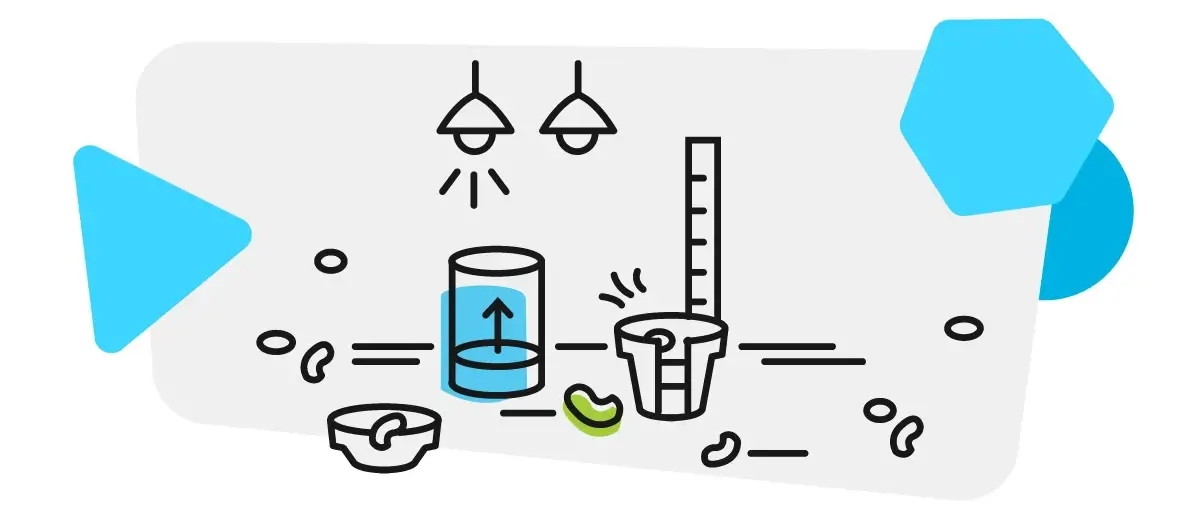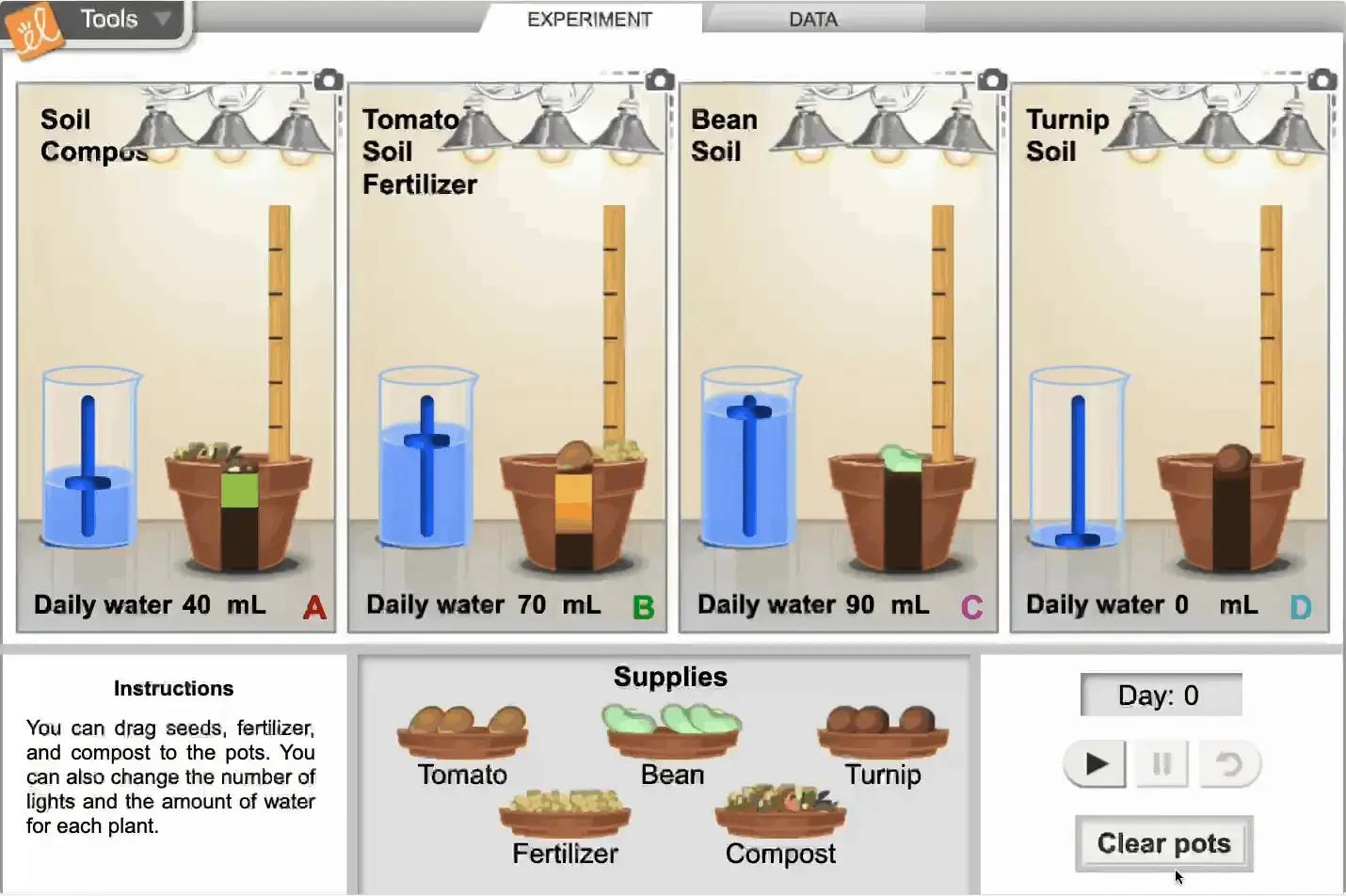Teach Plant Growth: Why It Matters and How to Use Virtual Labs

Teaching your students how to collect and analyze data while learning what healthy plants need to grow has never been easier or less messy! All it takes is an interactive plant growth virtual lab! Understanding plant growth is a key concept in life science that lays the groundwork for more complex topics like ecosystems and climate science. It’s also a great opportunity to develop scientific thinking and real-world connections.
With the right tools, like a plant growing simulation, teachers can engage students in hands-on learning that brings biology to life without needing soil, pots, or cleanup! And as a busy teacher, how great is the idea of not cleaning up after your students? Read on to learn more about the importance and basics of plant growth, as well as why interactive plant growth virtual labs might just become your new (or existing) best friend when it comes to teaching plant growth in the classroom!
Try Gizmos free for 45 days!
For a limited time, get an extended 45-day trial of Gizmos. Use code 45GIZIN to unlock your access. Transform your classroom and unlock students’ STEM potential today!
Why is understanding plant growth important?
Before starting a lesson on plant growth with students, they first might want to know why exactly it matters. Plant growth is more than just a classroom topic—it’s a window into the essential systems that support life on Earth. From agriculture and food production to ecosystems and climate change, plant science connects students to real-world challenges and opportunities. It’s also foundational to life science instruction and closely aligned with NGSS standards.
By exploring how plants grow, students begin to understand the flow of energy, the role of organisms, and the delicate balance of the environment. This kind of systems thinking is key to scientific literacy!
What do plants need to grow?
Whether you're digging in soil or diving into a virtual lab, students need to understand the seven essential things plants require to grow:
- Light – Fuels photosynthesis
- Water – Hydrates and transports nutrients
- Nutrients – Supports development and structure
- Air – Specifically, carbon dioxide is needed for photosynthesis
- Space – Important for roots and leaves to expand
- Temperature – Needs to be within the optimal range for growth
- Time – Gives the life cycle a chance to fully unfold
Using simulations or classroom experiments, teachers can walk students through these needs and allow them to manipulate variables to see how each factor affects plant development.
How do plants grow?
At the core of plant growth is photosynthesis, which is the process where plants convert light, carbon dioxide, and water into energy and oxygen. This energy fuels their growth from seed to maturity. As students explore plant biology, they can observe how changes in conditions like light, water, and nutrients impact plant health.
Simulations offer a perfect environment to introduce and apply the scientific method:
- Form a hypothesis about what might help or harm plant growth
- Test variables such as light or water in a controlled setting
- Analyze the results to draw conclusions and deepen understanding
These steps guide students to think like scientists and explore cause and effect in real time.
Improve plant growth instruction through simulations
There are a lot of questions about plant growth for students to investigate. How do plants eat? How does sunlight affect plant growth? Some of those questions can be difficult to answer with the limitations of environmental conditions at school, such as classrooms without windows for sunlight. And what about the time it takes to grow plants?
Plant growth experiments through virtual labs don’t have the restrictions of other types of investigations. That’s why plant growth virtual labs save the day!
As previously discussed, plants are an integral part of human and animal life, and having a basic understanding of how they grow is important. Online labs, such as plant growth experiments, allow students to see results within minutes that would otherwise take weeks.
Virtual labs like ExploreLearning Gizmos allow students to experiment and manipulate throughout the stages of plant growth. Simulations make it possible to manipulate environmental conditions and analyze outcomes. Students deduce the best conditions for growing plants and can even create their own experiments.
To sum it up, plant growth simulations can enhance the classroom environment by providing:
- Time-saving: Virtual labs compress weeks into minutes
- Accessibility: No need for soil, water, or natural light
- Flexibility: Students can manipulate variables without messy resets
- Classroom management: Less cleanup, more focus on inquiry

Teaching plant growth with the growing plants Gizmo
Plants are an integral part of human and animal life, and having a basic understanding of how they grow is important. Online labs, such as plant growth experiments, allow students to see results within minutes that would otherwise take weeks.
Virtual labs like ExploreLearning Gizmos allow students to experiment and manipulate throughout the stages of plant growth. Simulations make it possible to manipulate environmental conditions and analyze outcomes. Students deduce the best conditions for growing plants and can even create their own experiments.
Ready to elevate your science lessons?
You can share these impactful learning experiences with your students, too. The new interactive Gizmos Investigations are launching in fall 2025! Be the first to know about the product release and learn more about bringing Gizmos Investigations to your classroom.
Plant growth virtual lab Gizmo
Many factors affect plant growth, from the amount of light, water levels, and soil additives. The Growing Plants Gizmo saves time and reduces materials while teaching students about controlled experiments. Students draw conclusions through learning objectives, including exploring the effects of light intensity, water levels, and soil additives on plant growth. Students determine what a seed needs to grow into a healthy plant, design a controlled experiment to investigate a question, collect data from multiple trials, and analyze data using tables and graphs.

The Growing Plants Gizmo was modeled to be as realistic as possible. With this virtual lab simulation, students can manipulate four variables: seed type (bean, tomato, or turnip), soil additives (compost and fertilizer), amount of water, and amount of light. Students can use the Gizmo to try to grow the biggest plants they can or to investigate the effect of each variable individually.
Every Gizmo includes lesson planning materials, teacher guides, vocabulary, student worksheets, and assessment questions. Looking for even more ideas and information? Check out the Educator Resource Hub.
This detailed, interactive, online science simulation is the perfect option to investigate plant growth.
“Gizmos has allowed my students the opportunity to experiment using a virtual platform when hands-on materials are not available.” - Science Teacher
Why virtual labs belong in your classroom
Teaching plant growth helps students make meaningful connections between the science they learn and the world around them. It’s a versatile topic that supports curiosity, critical thinking, and scientific literacy. And with virtual labs, teachers can remove barriers like limited class time or materials while giving students the freedom to experiment and investigate. Tools like Gizmos offer NGSS-aligned, ready-to-use simulations that make it easy for students to explore, test, and learn in a dynamic digital environment.
Ready to bring plant growth experiments to life—without the mess? Try the Growing Plants Gizmo or explore our full Gizmos Biology Collection today!

How about including ExploreLearning Gizmos in more of your lesson plans? With virtual labs for grades 3-12, we have something for everyone.
Take a Trial